Hidden Vent Vinyl Soffit: Design and Benefits
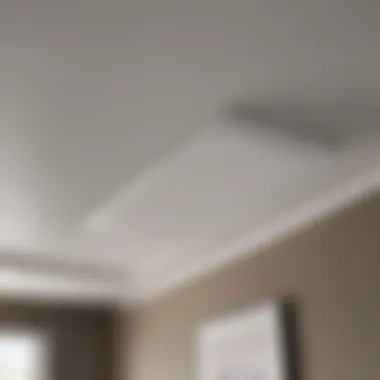
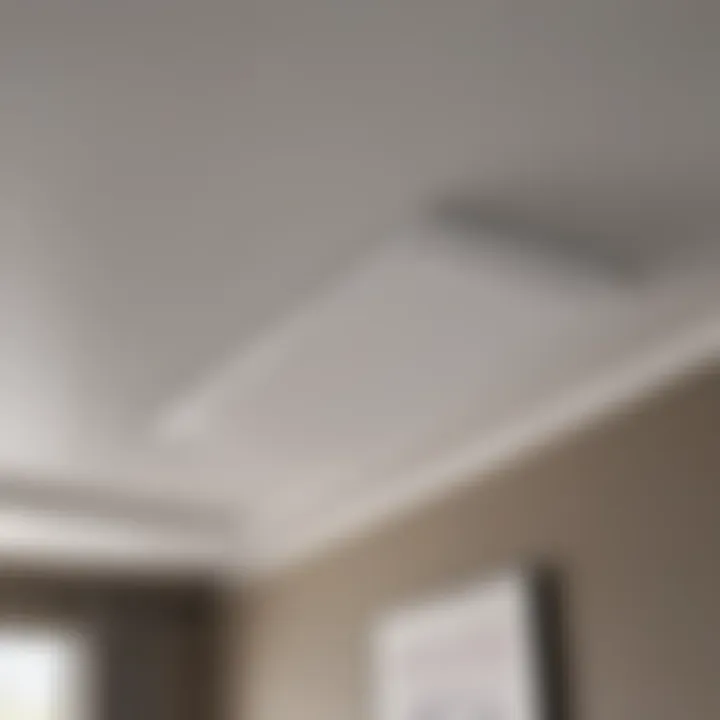
Intro
When considering upgrades for a home, many homeowners often overlook the significance of soffits. Hidden vent vinyl soffits can be a game changer for both aesthetics and functionality. These discreet architectural elements provide not just curb appeal but also play a key role in energy efficiency and moisture management within the home.
Overview of Topic
Hidden vent vinyl soffits are increasingly popular in the home improvement industry. Essentially, soffits are the underside of eaves or overhangs, providing a finished look to the structure while offering ventilation. What sets hidden vent vinyl soffits apart is their innovative design that conceals ventilation openings, maintaining a clean and sleek appearance. This elegance caters to both style and practicality.
The importance of the topic cannot be overstated. With evolving building standards and a growing emphasis on energy efficiency, hidden vent vinyl soffits can significantly enhance air circulation while minimizing the chances of moisture buildup. This is a boon for homeowners, as it helps to prevent mold growth and prolong the life of roof structures.
Common Challenges and Solutions
Homeowners often face several challenges when dealing with soffits. Here are a few common issues often reported:
- Moisture Accumulation: Poor ventilation can lead to damp areas, making spaces within homes susceptible to mold.
- Installation Difficulties: Many perceive soffit installation as an intricate task, causing hesitation.
To overcome these challenges, consider the following solutions:
- Ensure proper planning before installation. Familiarize yourself with the specific requirements of hidden vent vinyl soffits. Many manufacturers offer instructional guides.
- Engage professional help if the project feels overwhelming. Expert advice can save considerable time and efforts.
Product Recommendations
When examining products within this category, several standout options are available:
CertainTeed offers a range of hidden vent vinyl soffits that balance structure with style. Their products are designed with durability in mind, ensuring they withstand various weather conditions without fading.
Alcoa provides another great value option with their low-maintenance, high-performance vinyl soffits. These are particularly appealing for homeowners who prefer less frequent upkeep.
Royal Building Products boasts a stunning selection of styles that cater to varying tastes. These soffits are not only functional but also elevate the overall aesthetic of a home.
Step-by-Step Guides
Implementing hidden vent vinyl soffits can be straightforward if broken down into manageable steps:
- Planning: Measure the dimensions of your eaves, then select soffits that suit your needs.
- Materials Gather: Ensure you have all required tools and materials, including a ladder, measuring tape, and a saw.
- Installation:
- Finishing Touches: Ensure all edges are sealed for a neat appearance.
- Regular Maintenance: Inspect periodically to ensure no debris has accumulated and that ventilation remains unobstructed.
- Remove any old soffits carefully.
- Align the new soffit panel in place, ensuring the hidden vent is properly oriented.
- Secure the soffit using screws or appropriate fasteners as recommended by the manufacturer.
"Taking the time to properly install and maintain hidden vent vinyl soffits can lead to significant savings in energy costs and an enhanced living environment."
Prelude to Hidden Vent Vinyl Soffit
Hidden vent vinyl soffit might not be the flashiest topic in building materials, but a closer look reveals its pivotal role in home construction and renovation. This section will peel back the layers to examine both the significance and multifaceted benefits of this overlooked yet essential feature. Homeowners and builders alike stand to gain from understanding how hidden vent vinyl soffit contributes not only to enhancing a home's functionality but also to its overall aesthetic appeal.
Definition and Purpose
At its core, hidden vent vinyl soffit serves two primary purposes: ventilation and protection. While traditional soffits can be rather conspicuous, hidden vent designs cleverly integrate ventilation openings, allowing for unobtrusive airflow. This is crucial for managing moisture and maintaining a healthy attic environment, ultimately extending the life of a home’s structural integrity.
Hidden vent soffit can primarily be described as a perforated vinyl panel installed beneath the eaves of a home, where the roof overhang meets the walls. This ventilation system prevents stagnant air and helps control temperatures, further enhancing energy efficiency. By encouraging a smooth flow of air, it mitigates the risks of condensation, mold growth, and wood rot, which can be significant concerns in both old and new constructions.
Moreover, the choice of vinyl as a material offers homeowners a lightweight yet durable option that requires minimal maintenance compared to wood, which often bears the brunt of the elements.
Historical Context
Understanding the evolution of soffit systems provides further insight into why hidden vent designs are gaining traction. Traditionally, soffits were predominantly made from wood or aluminum. These materials offered some advantages; however, they came with their fair share of challenges. Wooden soffits, while pleasing to the eye, are prone to decay and insect damage. Conversely, aluminum may withstand the elements better but can easily dent or scratch.
In the early days, ventilation was often an afterthought in soffit design, leaving homes vulnerable to moisture-related issues. But as building codes and homeowner awareness evolved, the need for a better solution became apparent. Enter hidden vent vinyl soffit—combining modern material technology with functional design.
The innovative spirit behind hidden vent vinyl soffit can also be traced back to the shift toward more energy-efficient homes in the late 20th century. As homeowners became increasingly conscious of heating and cooling costs, solutions like this bifold design that promotes energy efficiency while being aesthetically pleasing emerged.
In the grand scheme of things, hidden vent vinyl soffit represents not just an advancement in building techniques, but an alignment with the modern homeowner's desires for practicality and style. Thus, it has transitioned from a niche element to an essential component in contemporary construction practices.
Understanding Vinyl Soffits
Vinyl soffits play a pivotal role in the construction and aesthetics of homes. By essentially acting as a finishing touch to both the underside of eaves and overhangs, they help improve a building's architectural appeal while serving practical functions like ventilation. Grasping the nuances of vinyl soffits can empower homeowners, builders, and architects to make informed decisions that align with both aesthetic desires and functional requirements. In this section, we will dissect the components that make up vinyl soffits, as well as shine the light on their advantages in construction.
Composition of Vinyl Materials
Vinyl materials are commonly derived from polyvinyl chloride (PVC), a versatile thermoplastic. The composition of these materials contributes to their robustness and longevity. Here’s a closer look:
- Polyvinyl Chloride (PVC): The primary ingredient that gives vinyl its strength and durability. PVC is resistant to moisture, making it a suitable choice for soffits that are continuously exposed to the elements.
- Additives: Various additives are mixed into the PVC. These can include UV stabilizers, which thwart degradation from sun exposure, and colorants that ensure uniformity and aesthetic appeal.
- Foaming agents: Some vinyl soffits incorporate foaming agents, creating an expanded cellular structure that enhances insulation and thermal performance. This can be a game-changer in reducing heating and cooling costs.
The composition of vinyl materials directly affects their performance, appearance, and lifespan. When curious homeowners are evaluating different types of soffits, the specifics of the material’s composition should be a top consideration—after all, choosing the right type can save costs down the line through reduced maintenance and replacement.
Advantages of Vinyl in Construction
When it comes to constructing or remodeling a home, vinyl materials present a range of advantages that can’t be overlooked:
- Durability: Compared to wood or aluminum, vinyl can withstand harsh weather conditions and resist fading over time. This durability translates to less frequent replacements and repairs.
- Low Maintenance: Vinyl soffits demand relatively little in upkeep. They can be easily cleaned with soap and water, freeing homeowners from the hassle of regular painting or staining, which is often required with wood materials.
- Cost-Effectiveness: Vinyl products typically come with lower upfront costs and potential long-term savings due to their durability and reduced maintenance needs. It’s an investment that pays off.
- Energy Efficiency: With improvements in insulation properties, vinyl soffits can contribute to energy efficiency in homes. They can help maintain steady temperatures within the attic or eaves, reducing energy bills.
In summary, the combination of favorable composition and inherent advantages positions vinyl soffits as a compelling choice for many homeowners. By understanding the nature of these materials and their benefits, one can appreciate their role in enhancing the overall efficiency and aesthetic of a property. Each element emphasizes the practicality of incorporating hidden vent vinyl soffits into modern construction.
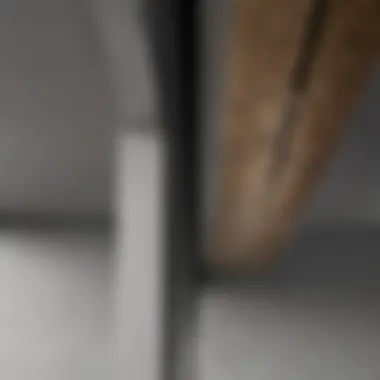
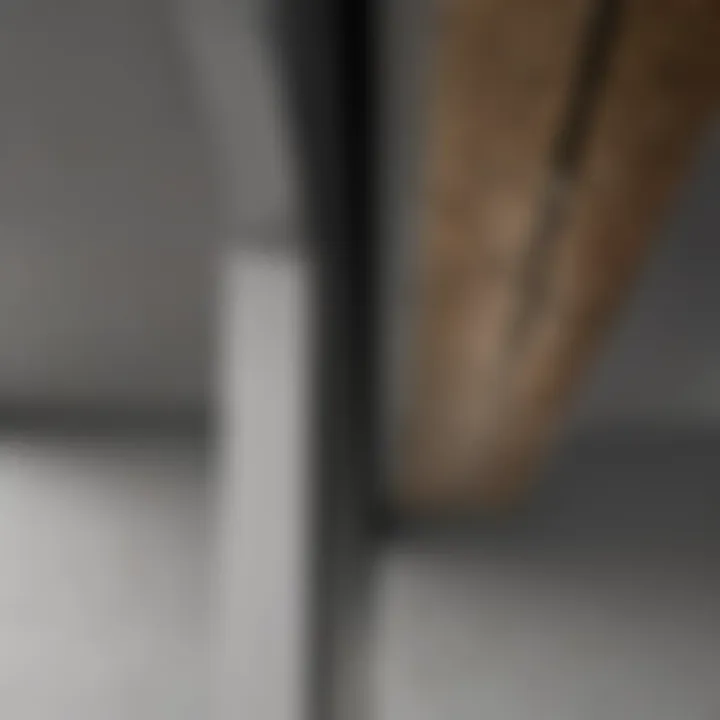
Benefits of Hidden Vent Design
The hidden vent design of vinyl soffits is not just a new trend; it's a significant enhancement in both functionality and aesthetics. This feature allows for a seamless appearance while promoting important aspects of home ventilation and moisture control. When it comes to home improvement, these benefits can profoundly affect the longevity and value of a property. Let’s break down these advantages into their key components: aesthetics, ventilation, and moisture control.
Improved Aesthetics
Homeowners often seek materials that enhance their property’s overall look. Hidden vent vinyl soffits excel in this department. Unlike traditional soffits that compromise style with exposed vents, hidden vent designs present a sleek, clean façade. This means less visual clutter around eaves and more cohesiveness in architectural style.
Furthermore, these soffits come in various colors and textures, catering to different tastes and home styles—from contemporary to rustic designs. The appearance is one of unison since the vents are integrated into the panels, making the home’s exterior more inviting. People passing by will notice a well-finished look that adds sophistication and elegance.
Some examples of color variations include soft whites mimicking classic wood, or deeper shades that resonate with modern designs. No matter the choice, a homeowners' investment in hidden vent vinyl soffits can indeed create a lasting impression.
Enhanced Ventilation
Adequate ventilation is crucial for maintaining an optimal interior climate. Hidden vent vinyl soffits promote airflow without compromising aesthetics. Unlike traditional soffit designs, which may obstruct airflow with visible vents, the hidden vent system facilitates efficient air circulation that helps balance internal temperatures.
This enhanced ventilation is essential for several reasons:
- Energy Efficiency: Improved airflow can reduce the need for heating and cooling systems, ultimately lowering energy bills.
- Indoor Air Quality: Proper ventilation reduces humidity levels, decreasing the likelihood of mold and mildew, which can cause health issues and structural damage.
- Comfort: With better ventilation, rooms feel fresher and more comfortable, creating a pleasant living environment.
Exploiting hidden vent soffits can contribute to a home that breathes, striking a harmonious balance between indoor comfort and outdoor aesthetics.
Reduction of Moisture Accumulation
Moisture can be the arch-nemesis of any structure. It leads to deterioration, peeling paint, and even insect infestations. The hidden vent design mitigates these risks effectively. By promoting airflow to reduce humidity levels, it actively prevents moisture from accumulating in the attic and under the roof.
When moisture is minimized, here are a few advantages seen at scale:
- Longer Lifespan of Structural Components: Less moisture means reduced risk of rot and decay in wooden structures, increasing the lifespan of a home.
- Cost Savings: Preventing moisture issues translates to lower repair costs and fewer maintenance hassles in the long run.
- Healthier Environment: A drier home reduces the risk of mold growth, which is a significant health hazard.
In an era where energy efficiency and sustainability are essential, hidden vent vinyl soffits emerge as a practical solution. This approach not only protects but also enhances the quality of life for homeowners. More than a trendy choice, this design integrates seamlessly into the home’s ecosystem, ensuring that beauty and functionality go hand in hand.
"Hidden vent vinyl soffits are not just about good looks. They represent a smart investment for both aesthetic appeal and structural integrity."
Installation Techniques
When diving into the world of hidden vent vinyl soffit, the installation techniques play a crucial role in ensuring a successful outcome, both functionally and aesthetically. It’s about getting things right from the get-go. Proper installation not only affects appearance but also influences durability and the overall performance of the soffit system. A meticulous approach sets the stage for a long-lasting, effective ventilation solution while enhancing the beauty of your home's exterior.
Pre-Installation Considerations
Before starting the installation, some key considerations will save you a world of trouble down the line. First, it’s vital to assess the existing structure. Take note of any obstructions, like rafters or other elements that might complicate your installation. Measurements should be accurate; this isn't just about eyeballing it.
Here are a few points to ponder:
- Material Quality: Not all vinyl materials are created equal. Opt for high-quality products that can withstand the test of weather and time.
- Tools Required: Have your tools ready. Essential tools include a level, measuring tape, snips, and a cordless drill.
- Safety Precautions: Never underestimate the importance of safety. Make sure to wear gloves, safety glasses, and a dust mask, especially if you're working in a dusty environment.
- Weather Conditions: Try to schedule your work for a dry day. Moisture can be a real nuisance during installation and may even affect the longevity of your soffits later.
By considering these elements beforehand, you'll be better prepared to tackle the task at hand. It may seem tedious, but a bit of forethought can make a considerable difference.
Step-by-Step Installation Process
Now that you're prepped and ready, let’s walk through the installation process step-by-step. This method will make sure every detail is taken care of to achieve that polished look you’re after.
- Preparation of the Area: Clear the area where you’ll be working. Ensure that the surface is clean, free of debris, and dry.
- Measuring and Cutting: Measure your vinyl soffit panels accurately according to the spaces available, then use a fine-toothed saw or snips to cut them to size.
- Installing Starter Strip: Attach a starter strip on the bottom edge of the eave. This provides a secure base for the installation, ensuring everything aligns correctly.
- Panel Installation: Begin installing the vinyl panels, locking them into place over the starter strip. Make sure to leave a little room for expansion, especially if the day is hot.
- Using Fasteners: Fasten your panels with the appropriate screws, being careful not to overtighten, as this can warp your materials.
- Finishing Touches: Finally, trim any excess materials and add additional trim pieces if needed, to give a finished look.
Following these steps, while maintaining a watchful eye for alignment and levels, will yield a visually pleasing and effective soffit installation.
Common Installation Challenges
Even the best-laid plans can go awry, so let’s address some common installation challenges that may pop up.
- Misalignment: If your soffit panels are not level, it can ruin the overall look. A common mistake is failing to check levels often as you go.
- Warpage: Improper cutting or fastening can lead to warping. Remember to avoid overtightening screws and leave space for thermal expansion.
- Weather Elements: As mentioned before, weather can be tricky. Wind can cause panels to sway or misalign. Always make sure you're working in suitable conditions.
- Inadequate Ventilation: Ensure that the vents are properly aligned with the soffit design. This will control air circulation effectively.
Proper preparation and awareness of common pitfalls can save your project from turning into a headache.
Maintenance and Care
Ensuring the longevity and aesthetic appeal of hidden vent vinyl soffits hinges on effective maintenance and care. Vinyl, while durable, requires attention to detail to uphold its performance and appearance over time. Homeowners and builders alike should recognize the significance of incorporating regular upkeep routines into their schedules. This not only enhances the lifespan of the soffiting but also prevents costly repairs down the line. Understanding the nuances of caring for these materials can transform mere installations into lasting structural assets.
Routine Cleaning Practices
Keeping the soffits clean is paramount for preserving their visual appeal and functional purpose. Here are some effective cleaning techniques:
- Frequency and Timing: Aim for bi-annual cleanings, ideally in the spring and fall. This helps remove debris like leaves or dirt buildup.
- Using the Right Tools: A soft-bristle broom or a low-pressure hose can do wonders in clearing out dirt without scratching the surface.
- Cleaning Solutions: A mixture of warm water and mild soap provides an effective solution for tougher stains. Avoid harsh chemicals that could degrade the vinyl.
- Spot Checking: After the main cleaning, inspect for specific areas requiring more attention, such as around vents or seams where grime can build up.
By adopting these practices, the hidden vent vinyl soffit not only maintains its pristine looks but continues functioning optimally.
Repairing Damage
Even the most durable materials can suffer from wear and tear. Knowing how to repair hidden vent vinyl soffits is essential for maintaining their integrity. Addressing minor issues promptly can avert larger problems in the future. Here’s how to tackle repairs:
- Identifying Damage: Regularly inspect your soffits for signs of warping, cracks, or discoloration. Catching these early allows for easier repairs.
- DIY Repairs: Minor cracks can often be patched with flexible vinyl repair adhesive. Simply clean the area, apply the adhesive, and smooth it out.
- Replacement Panels: For extensive damage, replacing individual panels might be necessary. Most suppliers offer the same styles and colors, making it easier to find an exact match.
- Professional Help: If damage is significant or you’re unsure about the repair, it’s wise to consult with professionals. They can assess the situation and conduct repairs correctly, ensuring your soffits remain in top shape.
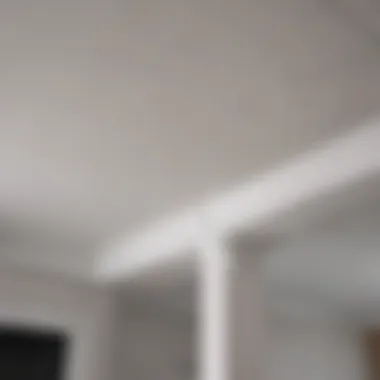
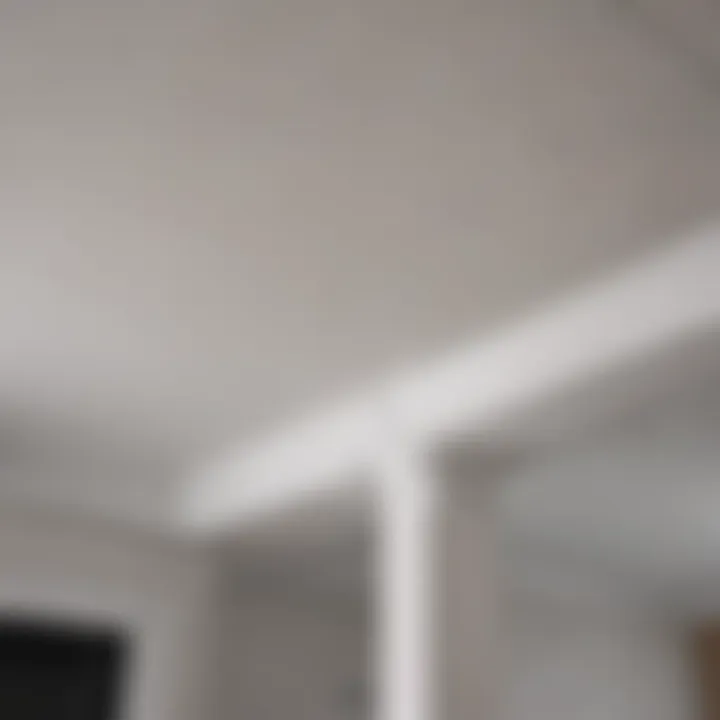
"Regular maintenance is no small feat; it’s the difference between a mere house and a well-cared-for home."
Integrating good maintenance and efficient care practices into your routine can ensure that hidden vent vinyl soffits remain not just functional but also captivating contributors to your home’s overall value. It's a balance of diligent attention and proactive repair that turns ordinary house components into extraordinary assets.
Comparative Analysis with Other Soffit Types
When it comes to selecting the right soffit for a home, a comparative analysis is crucial. Homeowners and builders alike need to consider various materials and designs, factoring in their unique characteristics as well as their practical applications. The decision between hidden vent vinyl soffits, wood soffits, and aluminum soffits can heavily influence not just the aesthetic appeal but also the durability and maintenance of the home. This exploration shines a light on two prevalent types of soffits: wood and aluminum, each offering distinct attributes and challenges when compared to their vinyl counterparts.
Wood Soffits vs. Vinyl Soffits
Choosing between wood and vinyl soffits involves weighing aesthetics against practical benefits. Wood offers an innate warmth and classic appearance that many homeowners cherish. Its natural beauty can complement traditional designs remarkably well. However, wood soffits are notoriously susceptible to rot, pests, and moisture damage, which can lead to costly repairs. Here’s a quick rundown of key considerations:
- Durability: While wood may look appealing, its lifespan can be significantly shorter in climates prone to moisture. Vinyl, on the other hand, offers resistance to weather conditions, making it a long-term investment.
- Maintenance: Wood requires periodic painting or staining to retain its appearance and integrity. Vinyl, with its low-maintenance appeal, only needs a simple wash to keep it looking fresh.
- Cost: The initial cost of wood soffits can be lower, but when factoring in maintenance and potential replacement costs, vinyl tends to emerge as the more economical option.
Aluminum vs. Vinyl Soffits
Aluminum has long been a popular choice, often praised for its robust nature and resistance to rust and corrosion. However, when it enters a showdown against vinyl, several factors warrant consideration. Here’s how they stack up against each other:
- Weight and Handling: Vinyl is lighter and simpler to install compared to aluminum. This can save both time and labor costs during installation.
- Insulation Properties: Vinyl soffits often offer better insulation compared to aluminum, which can lead to energy savings in climate control. A well-insulated home contributes to overall comfort and reduced energy bills.
- Appearance: While aluminum can be painted, its color options may not match the vast array of shades available in vinyl. Homeowners looking to match specific design schemes may find vinyl more accommodating.
In summary, while aluminum boasts strength, vinyl provides flexibility in design and superior insulation, ultimately leading to both aesthetic and functional benefits.
As one weighs these options, it becomes clear that the choice of soffit material extends beyond mere preference; it involves a detail-oriented examination of immediate needs, environmental factors, and long-term goals.
Environmental Impact
Understanding the environmental impact of hidden vent vinyl soffits is crucial in today’s eco-conscious landscape. Homeowners and builders alike are more aware than ever of the sustainability of materials used in construction. Each choice made can have ripple effects on the planet, making it imperative to analyze the components and lifecycle of vinyl soffits to form responsible decisions.
Sustainability of Vinyl Materials
Vinyl materials, primarily made from polyvinyl chloride, often raise eyebrows when it comes to their sustainability. Critics may argue about the harmful aspects of its production; however, when viewed holistically, vinyl can indeed be a sustainable option. Here's why:
- Longevity: Vinyl soffits are known for their durability and resistance to rotting or warping, which means they have a long lifespan compared to materials like wood. This longevity reduces the need for replacements, thereby minimizing material waste over time.
- Energy Efficiency: While installing hidden vent vinyl soffits, homeowners may notice added benefits in their homes' energy efficiency. The insulation properties of quality vinyl can help in regulating indoor temperatures effectively, lowering heating and cooling costs — a win for both the wallet and the environment.
- Low Maintenance: Vinyl soffits require scant upkeep, which means less time and resources spent on repairs or replacements. This is significant because maintenance often involves the use of additional resources or chemicals that can be harmful.
In essence, when weighed against alternatives, hidden vent vinyl soffits can contribute positively to sustainable building practices, provided they are produced with attention to environmentally-friendly processes.
Recyclability and Disposal
An often-overlooked aspect of vinyl soffits is how they fare at the end of their life cycle. The recyclability of these materials plays a pivotal role in their overall environmental impact. Here are some key points to consider:
- Recycling Possibilities: While vinyl is not always accepted by curbside recycling programs, many specialized facilities are equipped to handle it. Advocating for recycling can significantly lessen the burden on landfills and reduce pollution associated with producing new materials.
- Disposal Concerns: It’s paramount to consider how hidden vent vinyl soffits are disposed of at the end of their usefulness. Responsible disposal can be done through local recycling initiatives or waste management resources that emphasize recycling. Ignoring these guidelines can lead to more waste and environmental harm.
- Future Developments: As technology evolves, companies are focusing on creating vinyl products that incorporate recycled materials. This shift speaks volumes about the industry's capacity for change and adaptability.
Cost Analysis
Understanding the financial aspects of hidden vent vinyl soffits is crucial for homeowners and builders alike. A thorough cost analysis aids in assessing not only the initial investment but also the potential long-term financial benefits associated with this architectural choice. When considering soffits, it’s important to evaluate cost from multiple angles—not just the sticker price, but how these elements play into the broader financial picture of a project.
Initial Investment Costs
When embarking on an installation of hidden vent vinyl soffits, the first hurdle that homeowners often face is the initial investment costs. This cost can span a range of factors including the materials chosen, labor involved, and any preparatory work required before installation. Hidden vent vinyl soffits are unique in their design, and while they may carry a slightly higher price tag compared to traditional materials, it’s essential to weigh this against the long-term benefits they offer.
- Material Quality: Hidden vent soffits are crafted from durable vinyl that resists warping, fading, and damage from the elements. Investing in quality materials can lead to fewer replacements down the line.
- Labor Costs: Depending on the complexity of the installation, labor costs can vary significantly. Hiring experienced professionals who can guarantee a proper fit and finish might seem like a higher upfront investment, but it can prevent costly mistakes.
- Prep Work: Sometimes, the existing structure may require modifications to accommodate the new soffits. This might involve additional costs that can catch homeowners off guard.
Understanding these factors can help homeowners set a realistic budget, while also recognizing that a higher initial cost often correlates with better durability and aesthetics.
Long-Term Savings
Once the initial costs have been addressed, the focus can shift to the potential long-term savings offered by hidden vent vinyl soffits. These savings manifest in various forms, ultimately affecting the homeowner's pocketbook over the extended life of the product.
"Investing in quality materials today can lead to substantial savings tomorrow."
- Energy Efficiency: Hidden vent vinyl soffits allow for better airflow in attics or crawl spaces, which can help regulate temperatures within a home. This results in less strain on heating and cooling systems, leading to lower utility bills.
- Maintenance Savings: Unlike wood or aluminum, vinyl soffits typically require far less maintenance. There's no need for frequent painting, staining, or treatment against rot. This hands-off approach can lead to significant savings in labor and materials over the years.
- Longevity: Vinyl soffits have a long lifespan of 20 years or more when properly maintained. The initial investment is mitigated over time as homeowners do not need to incur the costs associated with replacing or extensively repairing materials that don't hold up.
In essence, while the initial investment in hidden vent vinyl soffits might give you pause, delving deeper reveals that the long-term savings often outweigh these upfront costs, leading to a financially sound decision for homeowners.
Trends in Soffit Design
In the realm of building design, soffits serve a purpose that’s far from superficial. They play a pivotal role not only in aesthetics but also in functionality. As trends in soffit design evolve, homeowners and builders alike are increasingly drawn to the hidden vent vinyl soffit, which truly marries purpose with style. By understanding the current trends, one can make informed decisions that enhance their living spaces.
Emerging Styles and Colors
The visual appeal of a home often begins with its exterior. As such, emerging styles and colors in soffit design are crucial to creating curb appeal. In recent years, there has been a notable shift towards more contemporary designs that incorporate a wider palette. Traditional whites and creams still wear the crown, but pops of color like deep blue or charcoal gray are fast becoming favorites. Installation of these vibrant shades can dramatically impact how a house is perceived, adding a touch of personality.
- Popular styles include:
- Board and batten patterns
- Smooth finishes that echo modern aesthetics
- Natural wood grains that provide texture
The use of colors allows homeowners to express individuality. Consider a deep forest green hidden vent vinyl soffit that beautifully contrasts with warm brick or stone walls. It’s all about creating a visual symphony that resonates with both the architecture and personal taste.
Integration with Modern Architecture
As homes grow increasingly sophisticated in their structural designs, integration with modern architecture becomes more important than ever. The hidden vent vinyl soffit fits seamlessly into contemporary homes thanks to its sleek lines and streamlined finish. It doesn’t just serve as a visual element; it enhances the overall architecture by providing coherent transitions between walls and roofs.
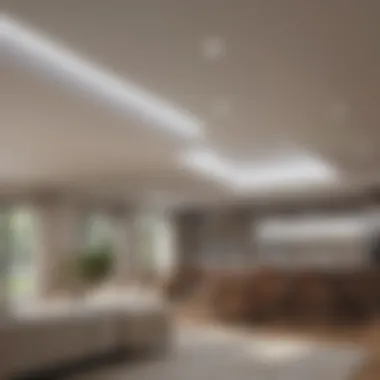
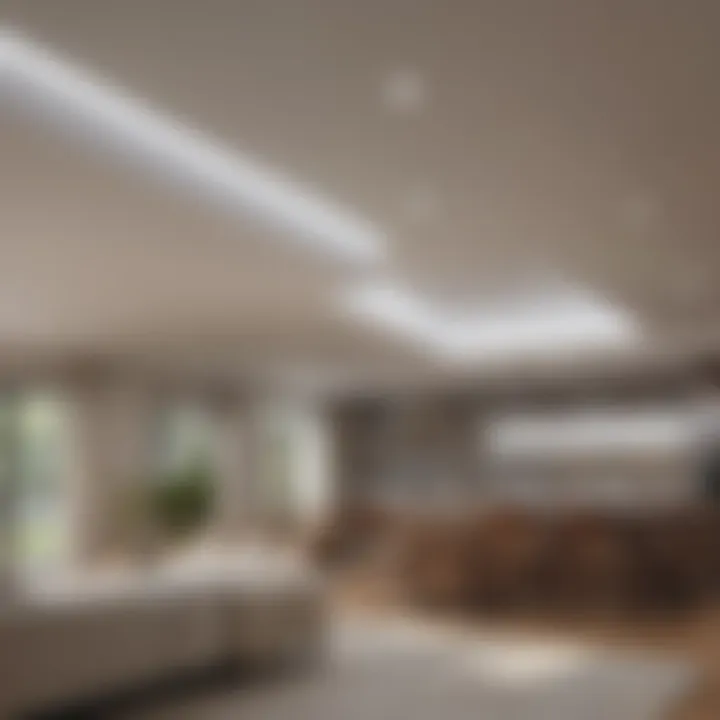
The way soffits are designed now goes hand-in-hand with the principles of energy efficiency. For instance, utilizing vinyl soffits can complement styles that emphasize large windows and open spaces, reflecting trends in sustainable living and energy usage.
The right soffit not only maintains the structural integrity of a building but also plays a vital role in the overall environmental footprint.
When planning for integration, it’s vital to consider architectural styles:
- Minimalist design: A unified look where hidden vent vinyl can support clean, sharp lines.
- Industrial themes: Adding a touch of sleekness to the rough textures embodying this style.
Ultimately, the trends in soffit design provide both beauty and function, ensuring that homeowners can create and maintain spaces that are not just livable but also visually stunning. Understanding these trends allows for the right choices that will stand the test of time, all while meeting both aesthetic and practical needs.
Case Studies
Exploring real-world applications of hidden vent vinyl soffits illustrates their growing popularity and versatility. Case studies provide valuable insights into how different spaces benefit from this specific soffit type. These examples not only highlight the aesthetic appeal of hidden vent designs but also their functional advantages in both residential and commercial settings.
Residential Applications
In residential settings, hidden vent vinyl soffits offer homeowners an array of benefits. One significant aspect is how they can seamlessly blend with various architectural styles. For instance, a suburban home remodeled with modern designs can utilize a hidden vent soffit to enhance its sleek exterior without compromising on ventilation. The discreet integration of ventilation prevents unsightly gaps while still maintaining necessary airflow.
Moreover, a real-life example involves a family in a humid climate. They chose to replace their existing wood soffits with hidden vent vinyl options. Not only did this upgrade eliminate the risk of wood rot, but it also significantly reduced their energy costs by improving air circulation in the attic. The result? A comfortable living environment year-round and less strain on the HVAC system.
Points to consider when evaluating residential applications include:
- Aesthetic Matching: The soffits can be personalized to match the home’s color scheme and design.
- Durability: Vinyl materials resist fading and weathering, making them a long-term investment.
- Home Value: Enhancing the exterior can positively impact property value, attracting potential buyers.
Commercial Installations
The use of hidden vent vinyl soffits in commercial applications is equally impressive. Businesses often require both functionality and curb appeal to attract customers, and these soffits deliver just that. For example, a storefront that opted for hidden vent vinyl soffits not only improved its overall appearance but also managed ventilation more effectively in the storage areas above.
Consider a restaurant with a beautiful outdoor patio. Installing hidden vent vinyl around the canopy allowed for excellent airflow while maintaining a clean, polished look. This choice proved beneficial in preventing moisture buildup, which is vital in a kitchen setting. Better ventilation can minimize complaints about odors while also maintaining the integrity of the building structure.
When looking at commercial installations, factors worth noting include:
- Brand Image: Well-maintained soffits contribute positively to a business's image.
- Functionality: Adequate ventilation leads to better temperature control and overall comfort for patrons and staff.
- Cost-Effectiveness: Investing in hidden vent vinyl can result in lower long-term maintenance costs compared to other materials.
"In both residential and commercial settings, the choice of soffits can significantly influence not just aesthetics, but also energy efficiency and comfort levels."
Through case studies like these, it’s evident that hidden vent vinyl soffits hold numerous advantages. They aren’t just a passing trend; they are a practical solution with proven success in real-life scenarios.
Future Outlook
In an ever-evolving architectural landscape, the future outlook for hidden vent vinyl soffits holds substantial significance for builders, architects, and homeowners alike. This outlook encapsulates not only advancements in materials and technology but also trends that can enhance building design and functionality. As builders and homeowners grapple with the dual demands of aesthetics and practicality, understanding this future direction can lead to more informed decisions regarding their construction and renovation projects.
Innovations in Vinyl Technologies
The advancements in vinyl technologies are indeed remarkable. Over recent years, innovations have been paramount in making hidden vent vinyl soffits not just practical but also visually appealing. New formulations of vinyl are resistant to fading, cracking, and peeling, ensuring that these soffits maintain their appearance for longer periods. The increase in durability is a game changer in reducing homeowners’ maintenance needs.
Moreover, the incorporation of advanced manufacturing techniques has led to improved designs that facilitate better ventilation while remaining inconspicuous. For instance, today’s soffits may utilize perforated designs that are amplifying airflow without compromising on looks. As the technology progresses, we may also see the rise of customizable options that allow homeowners to tailor color and texture preferences without sacrificing the benefits of hidden ventilation.
"With advancements sweeping through vinyl technology, the hidden vent soffit could very well become a staple in modern architecture."
Predictions for Industry Growth
The resurgence in interest in sustainability and energy efficiency suggests a bright future for hidden vent vinyl soffits. As builders are leaning more towards environmentally-friendly options, vinyl's recyclability plays in its favor. This demand is leading to predictions of substantial growth within the industry, as more homeowners are actively seeking materials that are not only efficient but less harmful to the environment.
In addition, the predicted integration of smart home technology into construction means that hidden vent vinyl soffits may need to adapt. Innovative solutions that incorporate sensors for monitoring airflow and detecting moisture could emerge, making these soffits even more functional and appealing.
To summarize:
- Increased performance: More durable materials will decrease the need for replacements and repairs.
- Customization: Homeowners might get options tailored specifically to their architectural styles.
- Sustainability focus: With environmental concerns taking center stage, more builders will likely choose vinyl materials.
As we look ahead, embracing these innovations and market trends will significantly influence building practices and home design. Staying informed allows homeowners and builders to make educated choices that align well with both their immediate needs and long-term aspirations.
Culmination
In the tapestry of home exterior design, hidden vent vinyl soffits play a crucial role in ensuring both functionality and style. They are more than just a protective barrier; they embody a thoughtful compromise between aesthetic appeal and essential utility. This article has peeled back the layers to reveal how such soffits can enhance ventilation and moisture control while elevating the overall beauty of a home.
As we wrapped this detailed discussion, a few specific elements have emerged as noteworthy:
- Aesthetics: The seamless integration of hidden vents contributes to cleaner lines and a polished finish. Homeowners often prefer designs that blend durability with visual charm, and these soffits fit the bill.
- Moisture Management: Effective ventilation contributes to a long lifespan for various structural elements of the home. Eliminating stagnant moisture can save homeowners from costly repairs down the road.
- Energy Efficiency: Proper airflow plays a part in maintaining optimal indoor conditions. With enhanced ventilation, energy costs can be reduced, leading to significant savings over time.
Understanding the importance of these factors is not just for designers and builders; it’s pertinent for every homeowner hoping to boost both the functionality and appearance of their dwelling. The comprehensive insights gathered here serve not only as a guide for installation and maintenance but also as a roadmap for making informed decisions about home exterior options.
Summary of Key Points
In contemplating the merits of hidden vent vinyl soffits, the following key points stand out:
- Versatility: They blend into various architectural styles without compromising design integrity.
- Low Maintenance: Made from durable materials that need minimal upkeep, these soffits are a homeowner’s ally.
- Venting without Visibility: The hidden vents offer a sleek look while carrying out their vital function.
- Cost-Effectiveness: The initial investment is balanced by the long-term savings on maintenance and energy.
Such attributes fundamentally transform how individuals perceive soffits, urging a deeper consideration beyond simple appearance.
Final Thoughts on Hidden Vent Soffits
As we conclude, one cannot ignore the impact that hidden vent vinyl soffits have on modern architecture and home improvement. They marry functionality with aesthetic appeal in a way that caters to a variety of needs. Homeowners, architects, and builders alike can appreciate how these soffits are designed not merely to fill a gap, but to create a comprehensive system of beauty and efficiency.
In an ever-evolving housing market, these soffits represent innovative thinking that can enhance property value while providing lasting advantages. Embracing the idea of a soffit that does more than just exist can lead to smarter design choices that reflect a homeowner's style and practicality.
When it comes down to it, it's about crafting living spaces that offer comfort and style. Hidden vent soffits accomplish this goal brilliantly, reminding us that good design ultimately benefits everyone.







